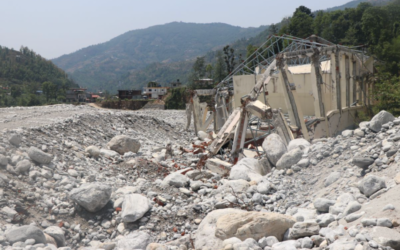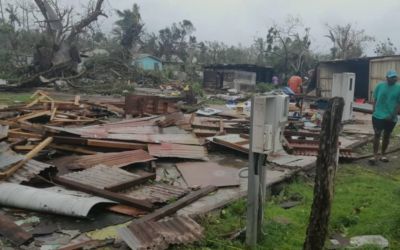By Basundhara Bhattarai | 18 September 2023
It was a fine day in July 2023 when I (along with my team members) was in a village in Timor Leste, situated northeast of Aileu town, a two-hour drive from the capital city of Dili. The road we travelled on was mostly smooth as we ascended up the moderately sloppy hills, but it had enough bends and some bumps that allowed us some extra moments to see the landscape from inside the car.
All along the way we had a wonderful opportunity to observe mosaics of forested landscapes and agricultural fields – the rich variety of plants, crops, and trees seemed to support food, livelihoods and ecosystems in the region.
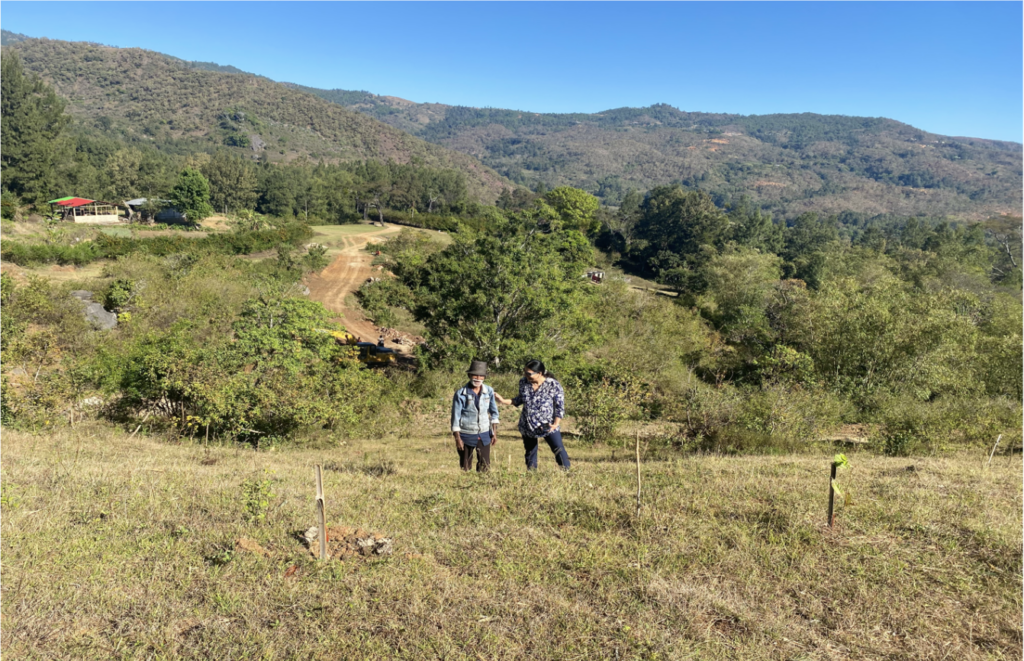
Agrobiodiversity landscape in Aileu
“Accidentally organic” food
After visiting a couple of farms and forest plantations, we were pleasantly surprised to be treated with steamed sweet potatoes and cassava from the locals. This was accompanied by mouth-watering gravy made from fresh chilies and tomatoes.
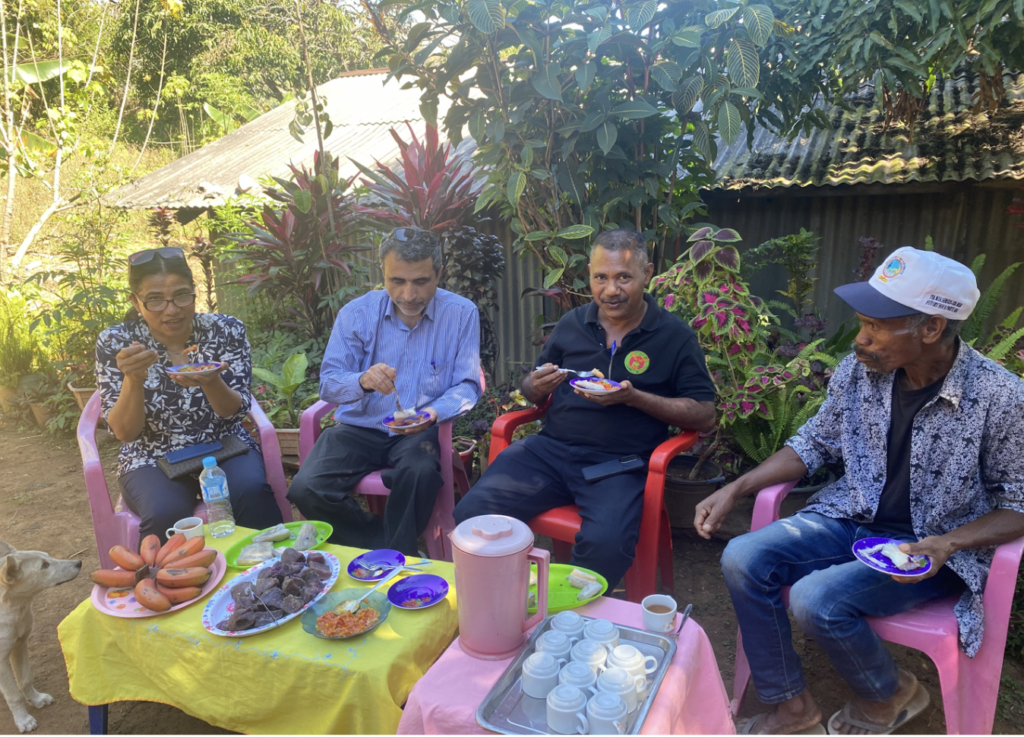
The visiting team enjoying the local organic food
The sweet potatoes served were dark purple – a variety known to be superior in nutrition compared to other species of sweet potatoes. What made the meal even more special was that all these foods were grown locally and organic with no additives or processing, sourced directly from the farm – and more importantly, served by the hands of the producers themselves with love and respect.
I struck up a conversation with one of the expat team members who had also joined us for lunch, commenting on how delicious the food was, noting its organic quality. To my surprise, he answered “This is accidentally organic because there is no supply of nasty chemicals and fertilizers, so this village had no chance of using chemicals.” This aligned with Timor Leste’s country-level statistics, which indicate that only 6% of the agriculture grown in Timor Leste is exposed to external inputs such as chemicals.
Staying organic is not enough
I couldn’t help but feel a little concerned with the idea of the produce being “accidentally organic” as it seemed the situation may not last long, given the rapid changes happening in Timor-Leste. The country is experiencing an acute shortage of food and the thrust to increase productivity through more inputs is coming from all sides.
Unfortunately, local production is only enough to feed 30% of its population, meaning that the remaining 70% of the population relies on food imports. According to Acute Integrated Food Security Phase Classification (IPC), between November 2022 – April 2023, 34% of the population in Timor-Leste was classified in the Phase 1 (No Acute Food Insecurity), 44% in Phase 2 (Stressed), 21% in Phase 3 (Crisis), and 1% in Phase 4 (Emergency) (Government of Timor-Leste, 2023).
This state of food security sits oddly with the fact that approximately 70% of the population relies on agriculture as a primary livelihood strategy. Among them, more women are dependent on agriculture than men.
Nutrition and food taboos
Throughout the city and village areas we visited, I noticed matured Moringa pods hanging from the trees, despite being fully ripe. Curious about why they were not being picked, I asked the locals if they were being saved for seeds. To my surprise, I got the answer that most people will not willingly consume Moringa pods due to societal taboo –as these pods were considered as “poor people’s source of protein” in the region.
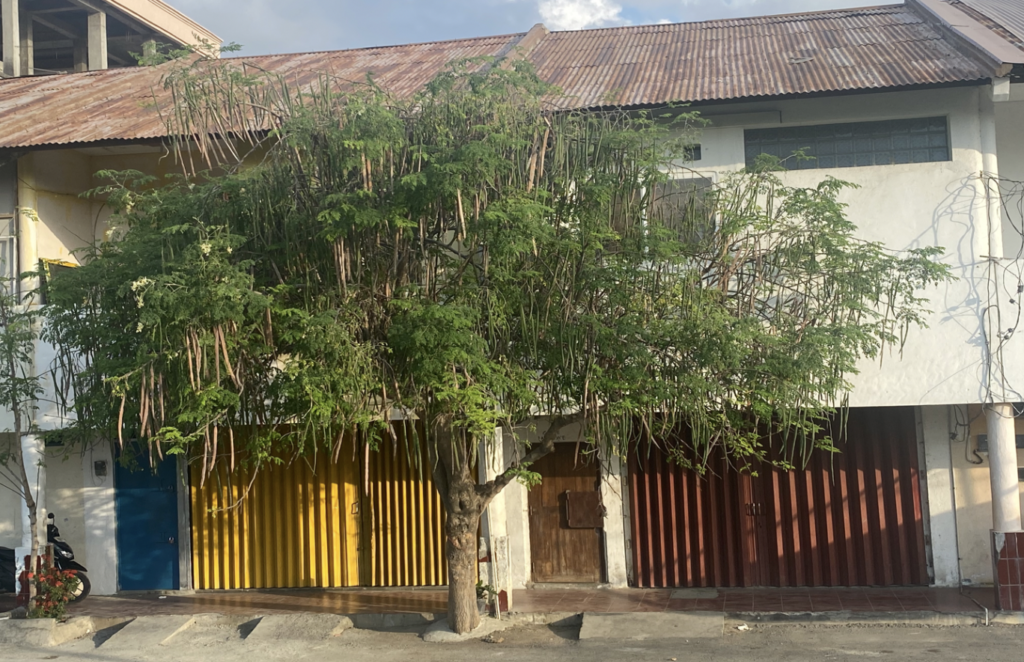
Unused pods of Moringa seen in Dili
There is also a different value put for imported over endemic food. We heard that the delicious (referred to as “accidentally organic”) dark-purple sweet potato is treated as inferior compared to imported potatoes. We were grateful to our local colleagues who provided such nutritious purple sweet potatoes for our lunch – indicating their rich understanding of its nutritional value and their belief that the social/cultural taboos surrounding such foods should change over time.
What surprised me even more is that despite the abundance of fresh coconuts in the country, the majority of local restaurants do not sell them. Instead, they predominantly sell imported soft drinks supplied in fancy bottles and packaging as is common in any town in the developing world.
Women leading the fresh vegetable market
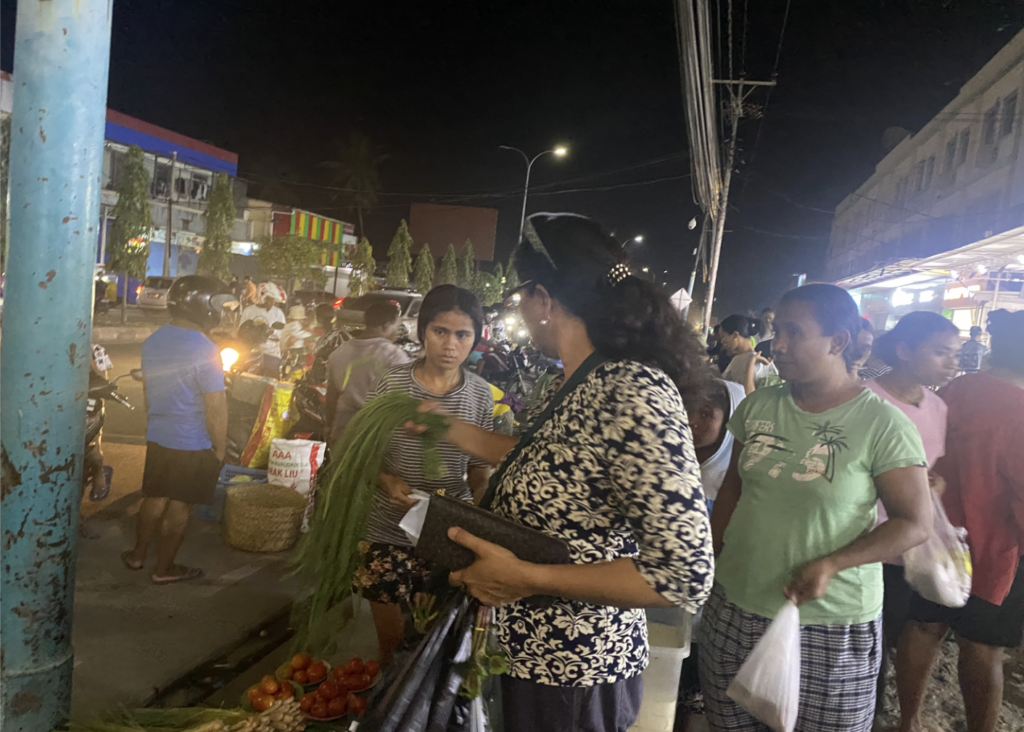
An evening vegetable market in Dili
During our time there, I noticed that women were at the forefront of supplying herbs and vegetables harvested both from forests and farmland. Every evening, I saw bustling fruit and veggie markets largely run by women as small entrepreneurs. This indicated women’s active involvement in collecting and harvesting food and vegetables from their private cultivation or publicly owned forested lands. I saw several varieties of wild fruits and vegetables including ferns shoots, and possibly wild casava roots. Timor Leste data shows that 37% of the food comes from these local forests. This also highlighted the vital role of women in ensuring food security and biodiversity in the region.
Timor-Leste’s Forests: A foundation for food Security and prosperity
During our visit to Aileu, we had the privilege of witnessing the development of forest plantation sites that are slated for transformation into agroforestry farms in the near future. The local community is also being supported to plant coffee seedlings underneath these emerging trees.
Moreover, the government has strategically outlined its priorities within the Ministry of Agriculture, Forestry, and Fishery, with a particular emphasis on coffee production and aquaculture. These sectors have been identified as key programs aimed at not only generating income but also improving overall nutrition and creating employment opportunities for the local population.
Remarkably, what ties all of these priority plans together is their close association with forest management and utilization. The forests play a pivotal role in shaping the success of these initiatives. They provide a foundation for sustainable food production and income generation for both individual households and the nation as a whole.
Some messages for the research and development community
The above observations and reflections now leave us with these four key questions which I would like to pass on to the research and development community in Timor Leste.
First, how can production and supply be augmented through more integrated forests and agriculture land management models? Such models should be developed across different socioecological zones with full consideration of the social-ecological systems thinking approach in place. These help to understand current practices of the forest-food/nutrition linkages and explore potential income and employment opportunities through sustainable management and conservation of watersheds and biodiversity.
Second, how can food behaviour be changed to better reflect the nutritional values of endemic plants? This includes government support for growing endemic crops that have high nutritional value over imported food and promoting the nutritional value of endemic foods to the public to reverse the current trend of considering imported food as superior to locally grown goods.
Third, how can Timor Leste avoid massive penetration of chemicals and pesticides in its quest for increasing food production for self-reliance in the near future but also find a balanced way between traditional organic culture and selective modernization?
Fourth, how can gender transformative change be promoted to integrate food production and nutrition more effectively? Contributing to gender transformative change can be one of the possible pathways for better-integrating food not only to increase production and income but also the nutritional dimensions of food. This can also help recognize women’s knowledge which is otherwise on the verge of disappearance.
Timor Leste’s transition from an oil economy to an agri-economy presents both challenges and opportunities. The transition will not be easy, considering underlying issues and challenges. Social-ecological system thinking could help better connect the agri-food-forest for advancing agri-production, food security, income and employment generation.
This blog is written by Dr. Basundhara Bhattarai, Institute of Study and Development Worldwide (IFSD), Australia. It can be cited as Bhattarai (2023). Timor Leste’s food system and agrobiodiversity in transition: Some observations and messages. IFSD Blog (IB-2023-06). https://ifsd.com.au/index.php/2023/09/16/timor-lestes-food-system-and-agrobiodiversity-in-transition/
Acknowledgment: The author would like to thank Dr Xisto Martin and his organization RAEBIA for their cooperation in the field trip.
Disclaimer: The views and information presented are those of the authors and in no way represent IFSD’s position


